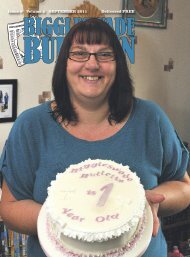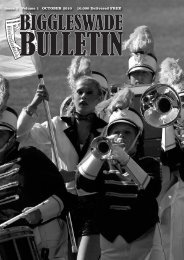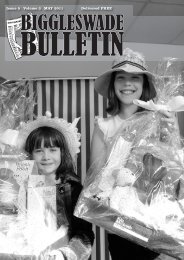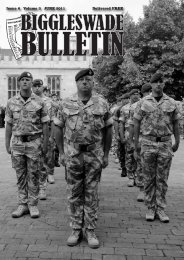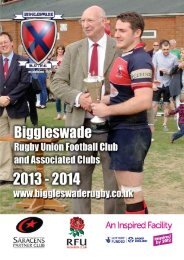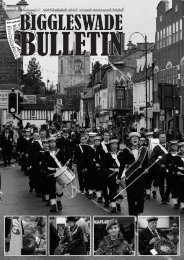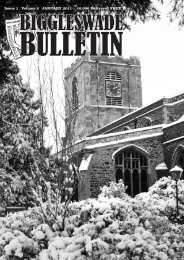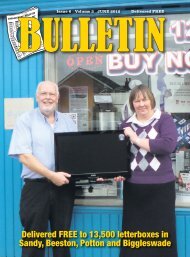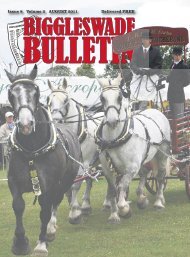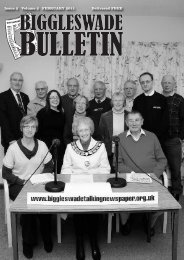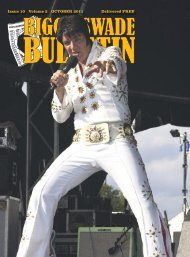24 BULLETIN APRIL 2012 TEL: 01234 834700 EDITORIAL: editorial@biggleswadebulletin.co.ukAnnouncements1. The Parish BoundaryBridge near Turnpike Farm. Weare pleased to note that, afterrepair works to this bridge overthe winter, the original boundarymarker keystone in the arch ofthe bridge has been preserved.When the re-rendering was donesome care was taken to avoidrendering over the keystone. It’sa relief that, having only discoveredthe inscription on the keystonelast May, we have not lostit under a layer of render! Thestone, dated 1879, is inscribedBIGGlESWADE to the left of acentral vertical line and SUT-TON to the right. The streamwhich flows under the bridgeforms the boundary between thetwo parishes.2. History Pin – New developmentsreported by ourWebmaster, Mike Strange.“On Sunday, 25 March newHistory Pin facilities are beingreleased and we are one of veryfew History Societies to be usingthem. There will be a dedicatedpage on our web site that enablesall of the images I have uploadedto be seen without the confusionof other photographs from otherpeople; this is called anEmbedded Channel. The otherquite exciting release will be aMobile App for smartphones(just Android, iPhone and thosethat are Windows-based). Thiswill enable the owners of suchphones to see nearby images thathave been uploaded in the contextof where they are.”Events & exhibitions1. library display. RoyChadwick’s window display ofbuilders’ plaques to be seenaround the town will be at<strong>Biggleswade</strong> library fromMonday, 2 <strong>April</strong> until Saturday, 28<strong>April</strong>.. Do come along and take apeek at the wealth of information,often unnoticed, to be found on<strong>Biggleswade</strong>’s buildings.2. Ken Page’s last slideshowof the season: ‘Millers &Merchants’, will take place at theConservative <strong>Club</strong> on Wed. 11<strong>April</strong>, starting at 8.00pm. Entryis free and open to all, and the<strong>Club</strong>’s bar will be available. Thenew Dan Albone hardback bookwill be on sale at the discountedprice of £20. Ken’s slideshows<strong>Biggleswade</strong> History Societyat the <strong>Club</strong> will resume inSeptember.News from the archivesOur thanks for the followingaccessions:1. The photos mentioned lastmonth, donated earlier this year:a variety of original photos ofMethodist Sunday school childrenand of the Shortmead Streetchapel dating from circa 1911,from Eric lund and Jean Carrick(via Roy Kitchener).2. Photos and memorabilia ofthe Wakes family of HitchinStreet loaned for scanning byAlison Harper.3. Donated by Cassi &Antonio Romano, a large metalcontainer for heating water, andcast iron door and grate removedfrom their Rose lane washhouseoutbuilding for preservation inour archive.PublicationsThe Society’s publicationsare on sale at 50p below list priceimmediately before and after ourmeetings and may also be foundat local outlets: Howells ofHitchin Street, Jordans Mill shopand Simply Oak. Please contactus about orders for collection orposting. The book list is on ourwebsite. The Dan Albone hardbackis still available to membersand non-members at the discountedprice of £20. Contactthe Society’s Editor for details.Last meeting06 March - ‘The VictorianWay of Death’ presented bysocial historian, Tom Doig. Tomgave an audience of 47 a fascinatingintroduction to thislugubrious topic. For theVictorians death was not a taboo,but a constant companion, and awhole culture had grown uparound it. Infant mortality wasvery high, childbirth frequentlycaused the death of mothers, andfar fewer adults than todayreached their three score and tenyears. Tom described a typicalsequence of events after a deathin a rural area. A cottager wouldgo down the garden and tell thebees in their straw skep. If youdid not keep the bees informedabout family events they wouldleave you! The sexton wouldthen be told so that he could ringthe passing bell: nine strikes for amarried man, followed by onetoll of the bell for each year of hisage. The undertaker would bringthe carpenter to measure for acoffin - some parishes kept a setof reusable coffins for pauperburials. All doors and windowswould be opened to allow thespirit to escape then all would beclosed up, blinds drawn, clocksstopped and mirrors turned to thewall. The deceased would beprepared, dressed in a shroud andThe <strong>Biggleswade</strong> History Society meets monthly at MillenniumHouse, Shortmead Street, <strong>Biggleswade</strong>. Doors open at 7.45pm for an8.00pm start on the first Tuesday of the month unless notified.Meetings are free to members; visitors will usually be welcome toour indoor meetings at a charge of £2.00 per meeting.The Full Programme for 2012:Mark these dates on your new calendar!1 May: <strong>Biggleswade</strong>’s Old SteelBridge – a talk by PabloHaworth12 June: Members only– Visit to St Mary’s Church,Gamlingay. Decoding thegraffiti.3 July: Members only– Visit to the SignalsMuseum, RAF Henlow.7 August: Members only– Visit to Stondon TransportMuseum. CAnCEllEDInstead we are pleased toannounce that Dr DavidMcOmish will lead a walkon the Common.See right coloumn four.14 Aug Members only - TheArchaeology of <strong>Biggleswade</strong>Common – a walk withDavid McOmish.4 September: Pickwick’s<strong>Biggleswade</strong> Scrapbook – atalk with a difference, byMike Petty.2 October: The Rise and Fall ofthe Cardington Airships – atalk by David Fowler.laid in the coffin on the table, alighted candle at each end. Alinen shroud was consideredbest, because Christ was buriedin linen.Cremation was illegal before1885 and the first municipal crematoriumopened in 1901, so virtuallyall Victorians were buried.Taphephobia – the fear of beingburied alive – was very real andstrange devices were designed toenable the occupant of a coffin tosend distress signals. Tom toldthe true story of a narrow escape:Matthew Wall of Braughing inHertfordshire was pronounceddead and was on his way to beburied, when a bearer slipped onwet leaves on the path to thechurch and the coffin wasdropped. Matthew emerged andwent on to live another 15 years!Walking funerals were thenorm in Victorian times and atown could be brought to a haltby a large funeral procession.Glass hearses (Washingtons)were rarely used; more often ahorse-drawn funeral wagonwould carry the coffin or thechurch bier (a hand-cart) mightbe used. Many cross-countryprocessional paths from hamletsto village churches have survivedto this day as public footpaths.A very uncommon common!When David McOmish gavea talk on The Archaeology of<strong>Biggleswade</strong> Common inFebruary he recommended abook. Impressed by his talk, Iafterwards obtained a copy: ‘AnArchaeology of Town Commonsin England’ by Mark Bowden,Graham Brown & Nicky Smith,published by English Heritage in2009. I wanted to know howimportant our common was andhow it measured up to other survivingtown commons inEngland. As part of an EnglishHeritage project begun in 2002nearly 350 towns were identifiedas having, or once having had,common lands and of these a variedsample of 60 or more survivingcommons were selected forsurveys. <strong>Biggleswade</strong> was one ofthose subjected to a level 1 (lessdetailed, lower technology)investigation. In short, at theback of the book, where the 350Continued on next pageFor further information contact: Jane Croot 01767 650340, editor@biggleswadehistory.org.uk www.biggleswadehistory.org.uk
TEL: 01234 834700 ADVERTISING: advertising@biggleswadebulletin.co.uk BULLETIN APRIL 2012 25The Fraternytye of Bycleswade –a pre-reformation religious foundationThe following featurearticle by Jane Croot firstappeared in the Biggles -wade History Society’snewsletter in november1997. It has beenrewritten, with additionalmaterial, for this issue ofthe <strong>Biggleswade</strong> <strong>Bulletin</strong>.The founding of chantries toprovide daily or weekly sungmasses for the souls of particularindividuals began in the thirteenthcentury and became commonpractice. Wealthy persons oftenhad a special chantry chapel built,like the one on Bedford’smedieval town bridge, and providedan endowment for its upkeepand for that of the chantry priest,who would chant mass and reciteprayers for the souls of the chosendeparted. Sometimes an existingreligious house or church wasasked to provide such services, anendowment was provided for thepurpose and a special chantrypriest appointed.There are known to have beenat least seventeen chantries inBedfordshire by the fourteenthcentury and they continued to proliferatein the fifteenth century. Bythis time many towns and villageshas religious fraternities or guilds.These were associations of peoplewho pooled resources to help oneanother in spiritual matters. Manywere associations of local professionals,tradesmen, craftsmen,farmers and property owners,whilst others, like the one atluton, had among their membersA very uncommon common!towns are listed, the ones with themost promising evidence ofarchaeological survival aremarked using a star system, fourstars being the best. <strong>Biggleswade</strong>is one of only eight on the list tohave been given four stars, alongwith the likes of York and lincoln!To quote from page 81: ‘At<strong>Biggleswade</strong> we have merelynoted the existence of a potentiallyvery significant surviving segmentof prehistoric, Romano-Britishand medieval landscape; largescalesurvey work is required hereto analyse and understand thedetail of this remarkable multilayeredsurvival. Though rare, thisis unlikely to be a uniqueinstance.’ (Jane Croot)wealthy clergy and gentry. Theypaid for chantry priests, providedthe necessary vestments andequipment for them, attended tomembers’ funerals and obits(prayers on the anniversary of adeath). The prayers of the living,especially of a priest, for the soulsof the dead; charitable gifts anddonations to church, fraternity orpoor made in life or in a will; pilgrimagesmade by friends or relatives– all these, it was believed inmedieval times, were effectiveways of easing the soul’s passagethrough purgatory after death.Sometimes the chantry priest wasalso the teacher at a small charityschool provided out of funds. Forthe members of a fraternity orguild there was the added socialdimension of occasional feasts andcelebrations on holy days.■ ■ ■About twenty Bedfordshireparishes had pre-reformation fraternities.<strong>Biggleswade</strong>’s was foundedabout the year 1464, in the reign ofEdward IV, and set up a chantry withits own priest in St Andrew’s churchin honour of the Holy Trinity.In his will dated 18 August, 1530in the reign of Henry VIII, WilliamWesterdale, bachelor of canon lawand parson of Edworth church,bequeathed money and property tothe <strong>Biggleswade</strong> guild of the HolyTrinity, among other bequests to themother church (lincoln cathedral),his own parish church and certainnamed individuals. Interestingly,two further bequests reveal that<strong>Biggleswade</strong>’s two hamlets – Holmeand Stratton – each had a chapel atthat time. The abstract that followskeeps the original spellings of theplace names and the original monetaryvalues (s.= shillings; d.= pence;12d.= 1s; 20s. = £1; 1 Mark = twothirds of a pound.)■ ■ ■…to the fraternity of the guild ofBekelliswade 20 marks, to be paid tothe guild priest as long as it lasts[this was to pay the priest to pray forWesterdale’s soul at regular intervals],on condition that the wardensof the guild maintain the farms andtenements belonging to the fraternityduring this time and give anaccount of them to testator’s executors.To the chapel of St Peter ofHolme 6s. 8d.; to the chapel ofStraton 13s. 4d.Various other bequests of money,property or goods then followed,mostly to named individuals, butone of them was a bequest to thefraternity ‘of Bekellswaide’ of ahouse, with the land belonging to it,‘in the Backe layne, sometimelangfords of Bekellswaide, next themessuage[house] once HenryCowper’s.’It was soon after WilliamWesterdale made his will that theDissolution of the Monasteriesbegan, in the mid-1530s. Henry VIIIbroke with Rome and established theChurch of England with himself, notthe Pope, at its head. Henrydestroyed the power of the oldchurch and stripped it of its wealth,its lands and buildings. In Bedford,Cauldwell Priory was dissolved in1536 and Newnham in 1539. TheFranciscan Friary [the Grey Friars]went at about the same time. WardenAbbey was dissolved in 1537,Chicksands Priory and WoburnAbbey in 1538. Monks were pensionedoff and the lands and buildingswere appropriated by theCrown and most were sold intoprivate ownership to raise revenue.The king then turned his attentionto the lesser religious foundations.The following is an extractfrom a survey of endowments forchantries, guilds and fraternities,carried out for Henry VIII in aboutthe year 1547. The spellings of theoriginal have been preserved…■ ■ ■‘The Fraternytye of Bycleswade.The landes belonging to the saidBrotherhedd… [There follows a listof lands, farms, tenants and rentswith a total valuation of 25s. 2d. perannum.] Md. that the saidFraternytye was lycenced to beerected founded and incorporate byKynd Edward the iiijth by the Nameof Wardens Brothers and Systers ofthe said Brotherhed and Guyld of theHoly Trynytie in the Churche ofSaynt Andrewe in Bicleswade aforesaidto thintent that there shold aprest syng there the dyvyne serviceand for to pray for the good estate ofthe sayd King Edward and QueneElizabeth then his wyfe and other theFounders and for the soules of thelate Duke of Yorke father to saidKyng Edward and for the soules ofall the brothern and systers of thesaid Brotherhed. Also there hath nogramar scole nor preacher ben keptthere syne Michmas last.Item, there hath no money norother proffet ben payd at any tymewithin this v.[5] yeres to any pooreperson out of the said Brotherhedintended to have continuance forever. Also there is in the said parisheof Bicleswade the number of ccccxl[440] houselyng people* and no moprestes but only the vicar and thisBrotherhed prest. Also there hathbeen no sale nor gifte of goodesspoyll voluntary wast or other distructyonin the said Brotherhed. AlsoHenry John is Incumbent there ofthage of xl [40] yere, but meanlylerned not able to serve a cure, andhath no lyving but this Brotherhed.’‘Houselyng people’ means communicants– persons who qualifiedto receive the ‘housel’, or host, atholy communion. Taking the numberquoted at a ratio of four to fivefor the population, this would give<strong>Biggleswade</strong> parish a population ofat least 550 in 1547, compared withapproximately 500 for Dunstableand 1,000 for Bedford St Paul.■ ■ ■When the chantries were suppressedin 1553 Henry Johnson, thechantry priest for <strong>Biggleswade</strong>’sFraternity of the Holy Trinity,received a pension of £3 3s. 4d. Nodoubt, the fraternity would have hada guildhall or house in <strong>Biggleswade</strong>where they met, but we have norecord of where in the town thismight have been, and it would probablyhave been sold off by theCrown along with any other propertythe guild owned.The little stone carving above theentrance to the 15th century porch ofSt Andrew’s church is thought to bea medieval representation of theHoly Trinity, a reminder of the guildof townspeople who, some five hundredyears ago, lived in this parish inthe hope that when they died theirsouls might be saved, helped by thedevotions, gifts and prayers of themselvesand their fellows, and of theirchantry priest, who may well oncehave occupied the small priest’sroom above the porch, later used as aschoolroom.■ ■ ■<strong>Biggleswade</strong> parish had not beenshort of clergy before theReformation. An early poll taxreturn of 1379, which included anexperimental taxation of the clergy,listed under ‘Bykeleswade’-Mr. Robert de Stratton, rector;John the Vicar;Chaplains:Thomas Wendeye,Robert Body, John de Cornewaile,John Tanntoft, Thomas French, JohnYate, Roger Balle, StephenStevenes;Clerks: Thomas Edmund,Richard Buntyng, John Mustel,William Donton, William Child andJohn Halsted.



